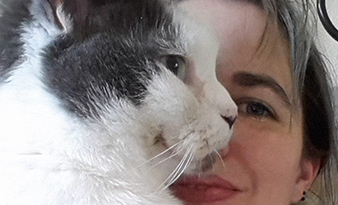What are your favourite animals?
My two rescue dogs.
What is your funniest vet moment?
Hmmm, I am not quite sure, this is a difficult one! This one is probably not particularly funny but demonstrates that even as a vet it is sometimes difficult to control what our pets do! One of our first rescue dogs was Tristan, a Border Collie with the appetite of a Labrador. He broke into cupboards, bins, stole food from the side table and cooker, and was very inventive when trying to find food to fill his stomach. Of course we tried our best to lock everything away but nevertheless Tristan managed to pinch unhealthy food such as a packet of butter or chocolate on numerous occasions. When I told my grand-dad (also a vet) about our dog’s most recent coup in which he secretly stole a jar of strawberry jam from the kitchen table, managing to unscrew the lid and devouring the lot, my grand-dad looked at me in disbelieve and said: “But as a vet you should know that jam is not good for dogs.” Of course I knew! Some pets are just very difficult to manage! Luckily, Tristan had a stomach of iron and never suffered any complications from his raids, but I must say that ever since then I have sympathised with owners of Labradors and other greedy dogs who find it difficult to keep their dogs from scavenging.
What is the most memorable or unusual animal you have treated?
An alpaca cria with a brain abscess which I saw during my residency at the Queen’s Veterinary School Hospital at the University of Cambridge.
What is your ultimate veterinary dream?
Increasing the knowledge in veterinary diagnostic imaging across the world to enable correct diagnosis and improve patient welfare.
Petra Agthe describes her journey to become a Diagnostic Imaging Specialist.
Although both my parents are vets (working in non-clinical disciplines), I initially wanted to pursue a more creative career and started studying architecture. However, after a year I realised that I would find more meaning in veterinary work and I was also missing the challenge of scientific conundrums.
After a couple of years in general veterinary practice I realised how much I still did not know! I found diagnostic imaging particularly interesting because it is often crucial in the puzzle to try and find out why a patient is sick. Also, as I am a very visual person, diagnostic imaging was for me the ideal combination of working with images and problem-solving while trying to help individual patients.
I now work in a multi-disciplinary small animal referral centre, and my job is very variable. It includes performing ultrasound examinations, interpreting radiographic, CT- and MRI-studies as well as fluoroscopy. This also includes helping our clinicians with external advice cases which we provide for our referring vets.
Other tasks include taking ultrasound or CT-guided biopsies from patients, and assist the surgeons and cardiologists with interventional procedures, such as intra-hepatic shunt attenuation.
Together with the other colleagues, I also have a role in Health and Safety, being responsible for the radiation and MR safety on site. Additionally, I also contribute to the formal and informal training opportunities for our interns and residents. As the head of department, I am also responsible for the overall organisation and smooth running of the diagnostic imaging team. So there is really never a quiet moment!
My favourite part of the job is actually Working in the clinic, where I can help a patient with my expertise. Sometimes we see very challenging cases and it is rewarding be able to reach a diagnosis or at least significantly narrow down the possible list of differential diagnoses, which enables the clinicians to treat or manage the patient in the best possible way.
Other useful links:
https://www.andersonmoores.com

